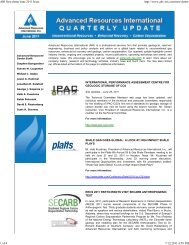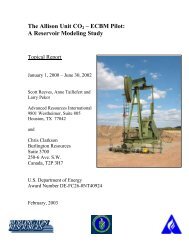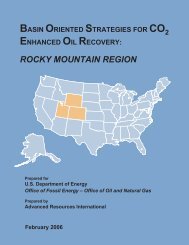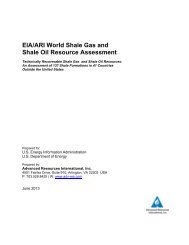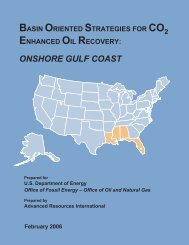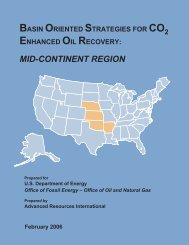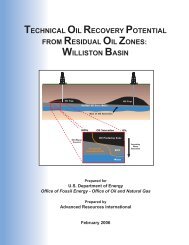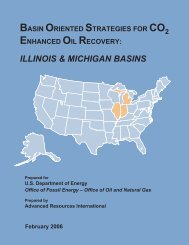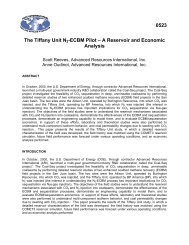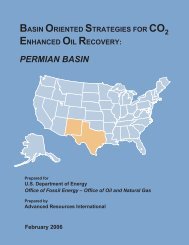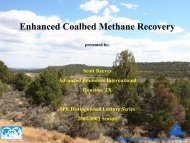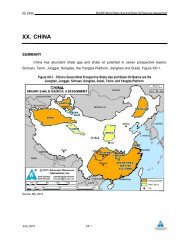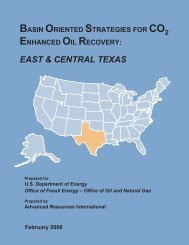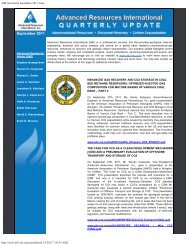Assessing Technical and Economic Recovery of Oil Resources
Assessing Technical and Economic Recovery of Oil Resources
Assessing Technical and Economic Recovery of Oil Resources
You also want an ePaper? Increase the reach of your titles
YUMPU automatically turns print PDFs into web optimized ePapers that Google loves.
I. INTRODUCTIONResidual oil zones (ROZ), the portions <strong>of</strong> oil reservoirs below their traditionalproducing oil-water contacts, can hold large volumes <strong>of</strong> previously undocumented <strong>and</strong>undeveloped domestic oil resources. The first comprehensive report on this topic,“Str<strong>and</strong>ed <strong>Oil</strong> in the Residual <strong>Oil</strong> Zone,” examined the origin, nature <strong>and</strong> presence <strong>of</strong>ROZ resources. 3 It set forth a preliminary estimate <strong>of</strong> 15 billion barrels <strong>of</strong> ROZ resourcein-place for the Permian Basin <strong>of</strong> West Texas <strong>and</strong> East New Mexico. This secondreport, “<strong>Assessing</strong> <strong>Technical</strong> <strong>and</strong> <strong>Economic</strong> <strong>Recovery</strong> <strong>of</strong> <strong>Oil</strong> <strong>Resources</strong> in Residual <strong>Oil</strong>Zones,” examines how much <strong>of</strong> this resource in-place may become technically <strong>and</strong>economically recoverable.A. Overview <strong>of</strong> ROZ <strong>Recovery</strong> Potential. Because <strong>of</strong> their low to moderateoil saturation settings, ROZ resources are not economic when using primary orsecondary oil recovery. As such, the great majority <strong>of</strong> domestic oil wells are completedabove the residual oil zone. Outside <strong>of</strong> the knowledge base being developed by a smallgroup <strong>of</strong> forward-looking operators, little is known about the ability to successfully target<strong>and</strong> produce the ROZ resource. However, in the current economic climate, withdepleting domestic oil reserves <strong>and</strong> operators’ desires to extend reservoir life, ROZresources <strong>of</strong>fer new sources <strong>of</strong> domestic oil production. Because <strong>of</strong> this, there isgrowing interest in further underst<strong>and</strong>ing the recoverable oil potential in the relativelythick (100 to 300 feet) residual oil zones located beneath the traditional main pay zones<strong>of</strong> oil reservoirs.Carbon dioxide (CO 2 ) enhanced oil recovery (EOR) has emerged as a viabletechnique for recovering residual oil left behind (“str<strong>and</strong>ed”) after waterflooding, mainlyin light oil reservoirs below 3,000 feet in depth. Yet, the oil saturation in the residual oilzones (ROZ) (<strong>and</strong> transition zones (TZ)) <strong>of</strong> a reservoir is <strong>of</strong>ten similar to the oil3 Melzer, S., (2006) “Str<strong>and</strong>ed <strong>Oil</strong> in the Residual Zone.” U.S. Department <strong>of</strong> Energy Report (underreview).1-1 February 2006



